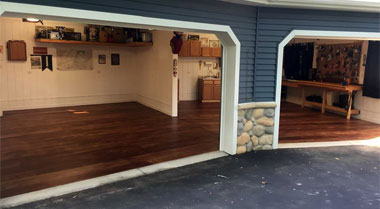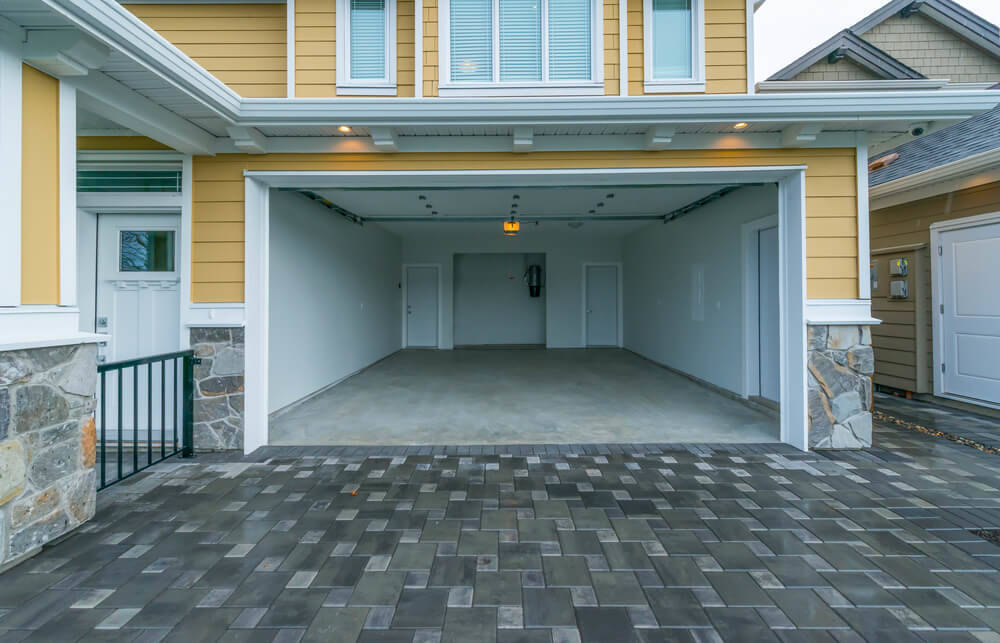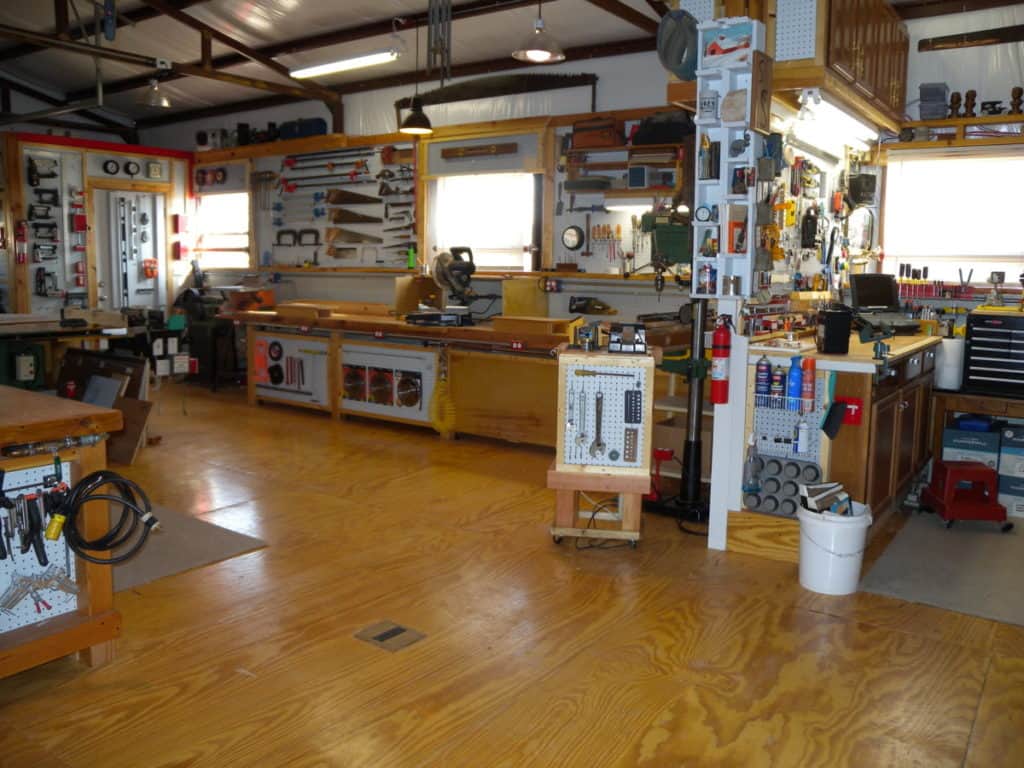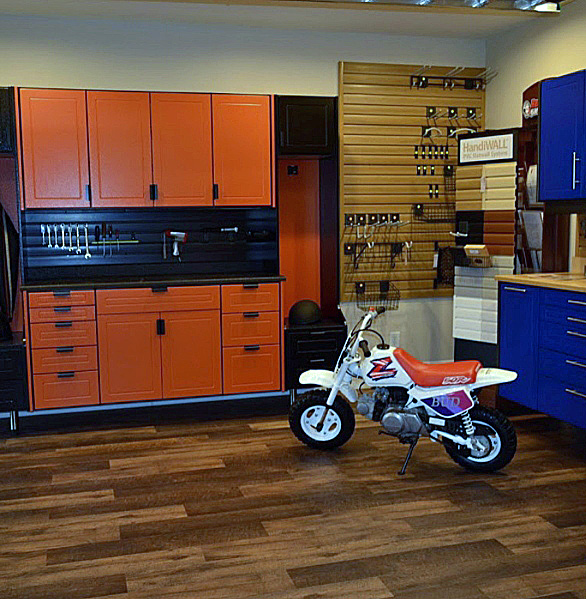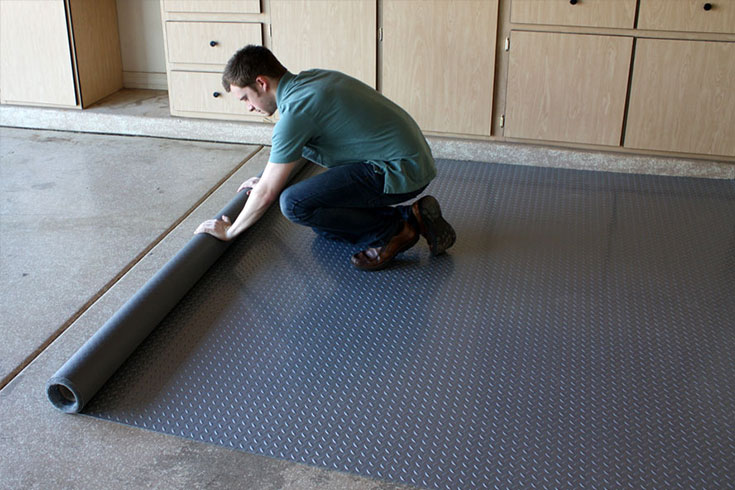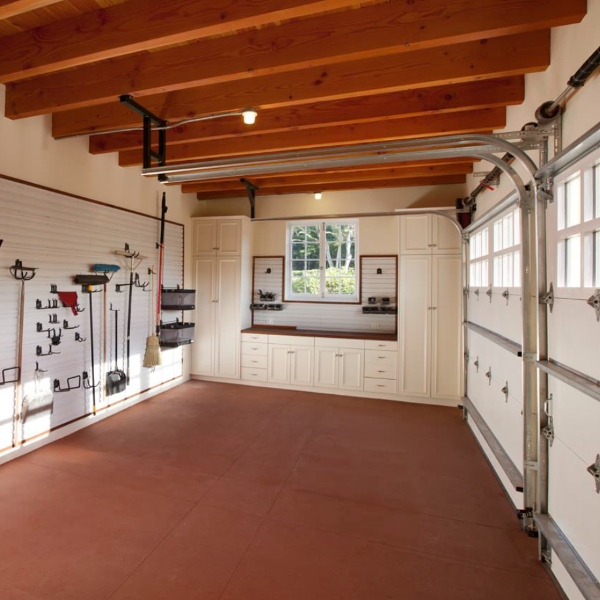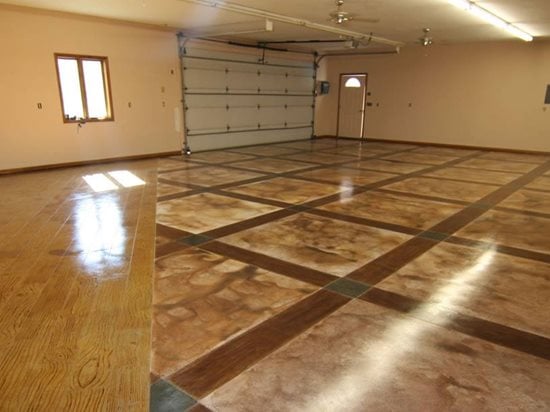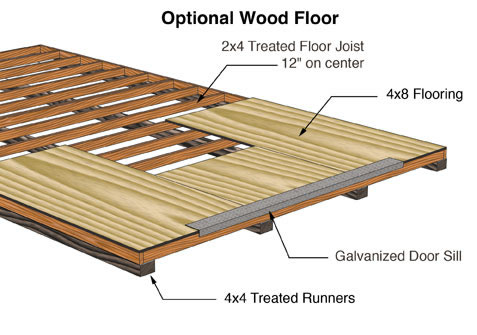Benefits of Choosing a Wooden Garage Floor
When I first considered the idea of installing a wooden floor in my garage, I was intrigued by the blend of warmth and functionality it offered. Wooden garage floors aren’t as common as concrete or epoxy, but they bring a unique set of benefits that can transform your garage into a more inviting and versatile space. Here’s why choosing a wooden garage floor might be one of the best decisions you make for your home.
- Aesthetic Appeal: The first thing that struck me about wooden garage floors was their undeniable aesthetic appeal. Unlike cold, hard concrete, wood brings a sense of warmth and coziness to the space. Whether you use your garage as a workshop, storage area, or even an extended living space, a wooden floor adds a touch of sophistication. The natural grain and color variations in wood can also complement other elements in your home, creating a seamless transition between your garage and the rest of your property.
- Comfort and Insulation: One of the most practical benefits I noticed with a wooden garage floor is the comfort underfoot. Wood naturally has insulating properties, which means it stays warmer in the winter and cooler in the summer compared to concrete. This is especially beneficial if you spend a lot of time in your garage, whether working on projects, exercising, or simply hanging out. The added insulation can also help reduce your energy bills by keeping the space more temperature-stable.
- Durability and Strength: Contrary to what some might think, wooden garage floors can be incredibly durable when properly installed and maintained. Hardwoods like oak, maple, and hickory are particularly strong and can withstand the weight of vehicles and heavy equipment. With the right protective finish, a wooden garage floor can resist scratches, dents, and wear, making it a long-lasting option for your space.
- Ease of Installation: I was pleasantly surprised to learn how straightforward it can be to install a wooden floor in a garage. Unlike concrete, which requires professional pouring and curing, wood can be installed using straightforward methods like tongue-and-groove planks or interlocking tiles. For those who enjoy DIY projects, this can be a satisfying and manageable task. The relative ease of installation also means that repairs or replacements are simpler and less costly.
- Versatility in Design: Wooden garage floors offer a level of versatility that you don’t often find with other materials. You can choose from a variety of wood species, finishes, and stains to match your style preferences. Whether you prefer a rustic look with reclaimed wood or a sleek, modern aesthetic with dark-stained hardwood, the options are nearly endless. This versatility allows you to customize the look and feel of your garage to suit your needs and taste.
- Environmental Impact: Another reason I leaned toward wood is its environmental impact. Wood is a renewable resource, especially if you choose sustainably sourced materials. Additionally, wood floors can be refinished or repurposed at the end of their life cycle, reducing waste. For those of us who are environmentally conscious, this makes wood a more eco-friendly option compared to non-renewable materials like concrete or synthetic tiles.

Types of Wood Suitable for Garage Floors
Choosing the right type of wood for a garage floor can feel overwhelming, given the variety of options available. When I was faced with this decision, I quickly realized that not all woods are created equal—some are far better suited for the rigors of garage use than others. Here’s a breakdown of the best types of wood to consider for your garage floor, each with its unique benefits.
Oak: The Classic Choice Oak is one of the most popular choices for wooden garage floors, and for good reason. This hardwood is known for its durability and resistance to wear, which is essential for a space that will see heavy traffic and possibly even vehicles. Oak’s tight grain also makes it less prone to absorbing moisture, a common concern in garages. Whether you choose red oak or white oak, this wood provides a timeless look that can be stained or finished to your liking.
Maple: Strength Meets Aesthetics Maple is another excellent option for garage floors. It’s incredibly strong, and able to handle the weight of heavy machinery or vehicles without showing signs of stress. What I love about maple is its light color and smooth grain, which can brighten up a typically dim garage space. It’s also less likely to splinter or crack, which adds to its longevity as a flooring material.
Hickory: The Heavy-Duty Option If you’re looking for a wood that can withstand the toughest conditions, hickory might be your best bet. Known for its hardness and resilience, hickory can handle heavy loads and resist wear and tear better than many other wood types. Its distinct grain pattern and range of colors—from pale to dark brown—give it a unique aesthetic appeal. For those who want a floor that’s both functional and visually striking, hickory is a solid choice.
Pine: The Budget-Friendly Choice For those of us working within a budget, pine offers a cost-effective solution without sacrificing too much in terms of performance. While softer than hardwoods like oak or maple, pine can still be a suitable option for a garage floor, especially if you’re using the space for lighter activities. Its natural knots and grain patterns give it a rustic charm that’s perfect for a workshop or casual garage setting. However, it’s worth noting that pine may require more maintenance and protective finishes to ensure it lasts.
Cedar: Naturally Resistant to Moisture Cedar is another great option, especially if you’re concerned about moisture and pests in your garage. This wood naturally repels insects and resists moisture, which can be a huge advantage in a garage setting. Cedar’s distinctive aroma and beautiful reddish hue also add a unique touch to the space. However, because it’s a softer wood, it’s best used in garages that won’t be subjected to heavy machinery or vehicle traffic.
Engineered Wood: A Modern Alternative If solid wood seems like too much of a commitment, engineered wood might be the compromise you’re looking for. Engineered wood is made of a thin veneer of real wood bonded to layers of plywood or high-density fiberboard. This structure makes it more resistant to moisture and temperature fluctuations, which is ideal for a garage environment. It’s also easier to install and generally more affordable than solid hardwoods, while still offering a similar look and feel.
Installation Process: How to Lay a Wooden Garage Floor
When I first decided to install a wooden floor in my garage, I was excited but also a bit daunted by the task ahead. However, with the right preparation and tools, laying a wooden garage floor can be a rewarding DIY project. Here’s a step-by-step guide to help you through the process, ensuring a smooth and successful installation.
Preparation and Planning Before you start, it’s crucial to prepare and plan out your project. Begin by measuring the dimensions of your garage to determine how much wood you’ll need. I found it helpful to add a little extra to account for mistakes or irregular cuts. Next, consider the type of wood you’re using and make sure it’s acclimated to the garage’s temperature and humidity for a few days before installation. This prevents the wood from expanding or contracting after it’s laid. Clear out the garage completely and clean the floor thoroughly, removing any dirt, debris, or oil stains that could affect the installation.
Subfloor Considerations A solid subfloor is essential for a stable wooden garage floor. Depending on your existing garage floor, you might need to install a plywood subfloor or an underlayment to provide a smooth, level surface. In my experience, laying a moisture barrier, such as a plastic sheet, is crucial, especially if your garage is prone to dampness. This layer helps protect the wood from moisture damage. Make sure the subfloor is secured well, with no loose boards or gaps, as this will impact the final installation.
Choosing the Installation Method There are several methods to install a wooden garage floor, and the right one for you depends on your skill level and the type of wood you’ve chosen. The most common methods are the nail-down, glue-down, and floating floor techniques. I opted for the floating floor method, which involves interlocking tongue-and-groove planks that “float” above the subfloor without being nailed or glued down. This method is easier for DIYers and allows the wood to expand and contract naturally.
Laying the Floor Once everything is prepared, it’s time to start laying the floor. Begin by placing the first row of boards along the longest wall, leaving a small gap (about 1/4 inch) between the wood and the wall to allow for expansion. Use spacers to maintain this gap. I found it helpful to stagger the joints between boards in different rows, which adds strength and creates a more visually appealing pattern. Continue laying the rows, carefully fitting each board together, and using a mallet if necessary to ensure a snug fit.
Cutting and Fitting As you work your way across the floor, you’ll likely need to cut boards to fit around obstacles like doorways, columns, or pipes. A jigsaw or circular saw works well for these cuts. Be sure to measure carefully before cutting to avoid wasting materials. When you reach the final row, you might need to trim the boards lengthwise to fit them into place. This part requires precision, but taking your time will result in a neat, professional-looking finish.
Finishing Touches After the floor is fully laid, you’ll need to remove the spacers and install baseboards or trim around the edges to cover the expansion gaps. This step not only enhances the appearance but also secures the edges of the floor. If your wood is unfinished, now is the time to apply a protective finish, such as polyurethane, to seal and protect the surface. I found that applying multiple thin coats, with light sanding in between, gives the best results. Finally, allow the floor to cure for the recommended time before moving any furniture or vehicles back in.
Maintenance Tips for Wooden Garage Floors
Once I had my wooden garage floor installed, I quickly realized that maintaining its beauty and functionality requires a bit of regular care. Wooden floors, especially in a garage setting, can be prone to wear and tear, but with the right maintenance, they can last for years. Here are some tips I’ve found helpful in keeping my wooden garage floor in top shape.
Regular Cleaning Routine The first and most important step in maintaining a wooden garage floor is establishing a regular cleaning routine. Dust, dirt, and debris can act like sandpaper on the surface, causing scratches and wear over time. I make it a habit to sweep the floor at least once a week, especially if I’ve been working on projects or driving the car in and out frequently. For deeper cleaning, I use a damp mop with a wood-friendly cleaner. It’s crucial to avoid excessive water, as wood is susceptible to moisture damage.
Protective Mats and Rugs One of the easiest ways to protect your wooden garage floor is by using mats or rugs in high-traffic areas. I’ve placed heavy-duty rubber mats near the garage entrance and under the car to catch dirt, oil, and water that might otherwise damage the wood. In areas where I work on projects or use tools, I’ve added padded mats to protect the floor from scratches or dents. Not only do these mats protect the wood, but they also provide additional comfort underfoot.
Addressing Spills and Stains Promptly Accidents happen, and when they do, it’s important to clean up spills as quickly as possible. Wood can absorb liquids, leading to stains, warping, or mold growth if not addressed promptly. I keep a microfiber cloth handy in the garage to blot up any spills immediately. For tougher stains, I’ve found that a mixture of vinegar and water or a specialized wood stain remover works well. Always test any cleaner on an inconspicuous area first to ensure it doesn’t damage the finish.
Regular Inspection and Repairs Regularly inspecting your wooden garage floor for signs of wear or damage is key to its longevity. Every few months, I take the time to closely examine the floor for any scratches, dents, or areas where the finish might be wearing thin. Small scratches can often be buffed out or treated with a wood touch-up marker, while deeper gouges may require filling with wood putty and refinishing. Catching these issues early can prevent them from becoming bigger problems down the line.
Reapplying the Finish Over time, the protective finish on a wooden garage floor can wear down, especially in high-traffic areas. To keep the floor looking its best and protect it from moisture and wear, it’s a good idea to reapply the finish periodically. I’ve found that doing this every couple of years, or as needed, keeps the floor in excellent condition. The process involves lightly sanding the surface to remove any old finish, cleaning thoroughly, and then applying a new coat of polyurethane or another wood finish.
Controlling the Environment Wood is sensitive to changes in temperature and humidity, so controlling the environment in your garage can help extend the life of your floor. I’ve installed a dehumidifier to keep moisture levels in check, especially during the humid summer months. If you live in a region with extreme temperatures, consider insulating the garage or using a space heater to prevent the wood from expanding and contracting too much. These small adjustments can make a big difference in the longevity of your wooden garage floor.
Protecting Wooden Garage Floors from Moisture and Damage
One of the biggest challenges I’ve faced with a wooden garage floor is protecting it from moisture and damage. Wood, while durable, can be vulnerable in a garage environment where it’s exposed to water, dirt, and heavy use. Through trial and error, I’ve learned a few effective strategies to safeguard my floor and keep it looking pristine. Here’s how you can do the same.
Applying a Moisture Barrier The first line of defense against moisture is a good-quality moisture barrier. If you’re installing a new wooden floor, this should be laid down before the wood planks. However, if your floor is already in place, applying a sealant to the underside of the wood can help. I chose a moisture-resistant underlayment during installation, which has been effective in preventing water from seeping up from the concrete below. This step is particularly important if your garage is in a damp or humid area.
Sealing the Wood Surface Sealing the surface of the wood is another crucial step in protecting your garage floor. A high-quality sealant or polyurethane finish creates a protective layer that repels water, oil, and other liquids. I’ve found that applying multiple coats of sealant, with light sanding in between, provides the best protection. It’s important to reapply this finish periodically, especially in high-traffic areas, to maintain its effectiveness. This not only protects the wood but also enhances its natural beauty.
Using Floor Mats and Trays Floor mats and trays are a simple yet effective way to protect your wooden garage floor from moisture and damage. I’ve placed a heavy-duty rubber mat near the garage entrance and under the vehicle to catch any water, mud, or debris that gets tracked in. For added protection, I use a drip tray under my car to catch any leaks or spills. These mats and trays are easy to clean and can be replaced if they become worn, keeping the underlying wood in good condition.
Managing Humidity Levels Wood is highly susceptible to changes in humidity, which can cause it to expand, contract, or even warp. To prevent this, I’ve installed a dehumidifier in the garage to control the moisture levels. It’s also a good idea to check for any leaks or sources of moisture that could be affecting the humidity, such as pipes or windows. By keeping the humidity in check, you can help maintain the integrity of the wood and prevent damage over time.
Protecting Against Heavy Impacts Garages are often home to heavy equipment, tools, and vehicles, all of which can damage a wooden floor if not properly managed. To protect my floor, I use padded mats in areas where I’m working with heavy tools or machinery. For vehicle storage, I’ve placed protective pads under the tires to distribute the weight more evenly and prevent indentations in the wood. Being mindful of how weight is distributed across the floor can significantly reduce the risk of dents and scratches.
Regular Maintenance and Inspection Regular maintenance is key to preventing damage and prolonging the life of your wooden garage floor. I make it a habit to sweep and mop the floor regularly to remove dirt and debris that could cause scratches. It’s also important to inspect the floor periodically for any signs of damage, such as cracks, warping, or discoloration. Addressing these issues early on can prevent them from becoming bigger problems that are harder to fix.
Comparing Wooden Garage Floors to Other Flooring Options
When I was deciding on the best flooring option for my garage, I found it helpful to compare wooden garage floors to other popular materials like concrete, epoxy, and rubber. Each flooring type has its own set of advantages and drawbacks, and understanding these can help you make an informed decision. Here’s how wooden garage floors stack up against the competition.
Wood vs. Concrete Concrete is perhaps the most common garage flooring material, known for its durability and low maintenance. However, I found that concrete can be cold, hard, and unforgiving, especially if you spend a lot of time in your garage. In contrast, a wooden garage floor offers a much warmer and more comfortable surface to walk and work on. While wood may require more maintenance, such as sealing and refinishing, its aesthetic appeal and insulation benefits often outweigh the simplicity of concrete.
Wood vs. Epoxy Coatings Epoxy-coated floors are another popular option, particularly for those looking for a sleek, durable surface. Epoxy is resistant to chemicals, stains, and heavy traffic, making it ideal for a garage. However, applying epoxy can be labor-intensive and requires a perfectly prepared concrete base. In my experience, wooden garage floors are easier to install and offer a more natural look that can be customized with different stains and finishes. While epoxy may be more resistant to wear and tear, wood brings a unique charm and warmth to the space.
Wood vs. Rubber Flooring Rubber flooring is often chosen for its durability and shock-absorbing properties, making it ideal for home gyms or workshops within a garage. Rubber is also resistant to moisture and easy to clean. However, it lacks the aesthetic appeal and warmth of wood. When I considered rubber, I found that it didn’t offer the same inviting atmosphere that a wooden floor does. Wood can also be more versatile in design, with options ranging from rustic to modern styles, while rubber tends to be more utilitarian in appearance.
Wood vs. Vinyl and Laminate Flooring Vinyl and laminate floors are cost-effective alternatives that mimic the appearance of wood while offering more resistance to moisture and scratches. These materials are also easier to install than traditional hardwood. However, I found that they don’t quite match the authenticity and feel of real wood. While vinyl and laminate can be great options for those on a budget or those who need a highly durable surface, they lack the character and natural beauty of a true wooden garage floor.
Wood vs. Tile Flooring Tile flooring, whether ceramic or porcelain, offers a durable and water-resistant surface that’s easy to clean. However, tiles can be slippery when wet and may crack under heavy impact. When I considered tile for my garage, I realized that it wouldn’t provide the same warmth and comfort underfoot as wood. Additionally, the grout lines in tile floors can be difficult to keep clean, especially in a garage environment where dirt and grease are common. Wood, on the other hand, offers a seamless and comfortable surface that’s easier to maintain in the long run.
Wood vs. Carpet Carpet is a less common choice for garages, but it can be a good option for those who use their garage as a multipurpose space, such as a home office or recreational room. Carpet provides warmth and comfort but can be difficult to keep clean in a garage setting, where spills and dirt are more likely. In my opinion, wood offers a better balance between comfort and practicality, as it’s easier to clean and maintain while still providing a warm and inviting atmosphere.
Common Mistakes to Avoid When Installing Wooden Garage Floors
Installing a wooden garage floor can be a rewarding project, but it’s important to avoid common mistakes that can lead to problems down the line. Based on my own experience and research, here are some pitfalls to watch out for during the installation process.
Skipping the Moisture Barrier One of the most common mistakes is neglecting to install a moisture barrier under the wood planks. Without this, moisture from the concrete slab can seep into the wood, causing warping, mold, or rot. Always ensure you lay down a high-quality moisture barrier before installing the wood flooring.
Using the Wrong Type of Wood Not all wood is suitable for garage floors. Softwoods like pine are more prone to dents and scratches, while hardwoods like oak or maple are more durable. Choose a wood species that can withstand the demands of a garage environment, and consider using pressure-treated wood for added durability.
Ignoring Expansion Gaps Wood naturally expands and contracts with changes in temperature and humidity, so it’s important to leave expansion gaps around the edges of the floor. Failing to do so can result in buckling or warping over time. Use spacers during installation to ensure consistent gaps.
Improper Surface Preparation Installing wood flooring over an uneven or dirty surface can lead to problems with alignment and stability. Make sure the concrete slab is clean, level, and free of debris before starting the installation. If necessary, use a self-leveling compound to correct any imperfections.
Rushing the Installation Installing a wooden garage floor requires patience and attention to detail. Rushing the process can lead to mistakes that are difficult to fix later on. Take your time with each step, from laying the moisture barrier to nailing or gluing down the planks. Double-check measurements and alignments to ensure a professional-looking finish.
Neglecting Regular Maintenance Once the floor is installed, it’s important not to neglect regular maintenance. Failing to clean the floor regularly, reapply the finish, or address spills and stains promptly can shorten the lifespan of the wood. Establish a maintenance routine and stick to it to keep your wooden garage floor looking and performing its best.
Is a wooden garage floor durable enough for heavy vehicles?
Yes, a wooden garage floor can be durable enough for heavy vehicles, especially if you choose a hardwood species and ensure proper installation. Using protective mats under the tires can also help distribute the weight and prevent dents.
How do I prevent moisture damage to a wooden garage floor?
Prevent moisture damage by installing a moisture barrier under the wood planks, sealing the wood surface with a high-quality finish, and controlling the humidity levels in the garage with a dehumidifier.
Can I install a wooden garage floor myself, or should I hire a professional?
Installing a wooden garage floor can be a DIY project if you have experience with flooring installation and the right tools. However, if you’re unsure or want a flawless finish, hiring a professional might be the better option.
What type of wood is best for a garage floor?
Hardwoods like oak, maple, or hickory are ideal for garage floors due to their durability and resistance to dents and scratches. Pressure-treated wood is also a good option for added moisture resistance.
How do I clean and maintain a wooden garage floor?
Clean the floor regularly by sweeping to remove dirt and debris, and use a damp mop with a wood-friendly cleaner for deeper cleaning. Reapply the finish as needed and address spills or stains promptly to prevent damage.
Can a wooden garage floor be used in all climates?
Yes, but you’ll need to take extra precautions in areas with high humidity or temperature fluctuations. Installing a moisture barrier, sealing the wood properly, and controlling the environment in the garage can help ensure the longevity of the floor.
Spruce Up Your Shop: Install a Wood Floor
Take Your Garage to Next Level with Luxury Vinyl Garage Flooring
Garage Floor Resurfacing: Fix a Pitted Garage Floor (DIY) Family
Garage Floor Coating u0026 Concrete Finishes – Concrete Network
Rustic Wood Flooring Concrete Wood Flooring Contractor
OT – Garage flooringanyone using porcelain tile
Sierra 12×24 Wood Storage Garage Shed Kit – ALL Pre-Cut
Related Posts:
- Epoxy Garage Floor Coating
- Garage Floor Paint Green
- Garage Floor Resin
- Concrete Garage Floor Design
- Garage Floor Epoxy Ideas
- DIY Garage Floor Tiles
- Car Garage Floor Tiles
- Garage Floor Epoxy Paint
- Garage Floor Paint
- Garage Floor Epoxy Finish
